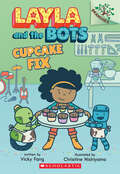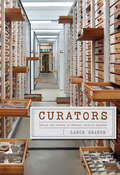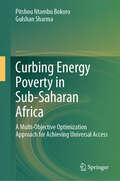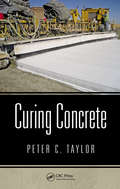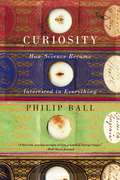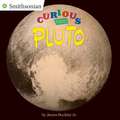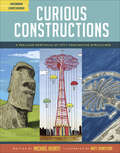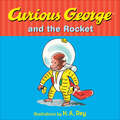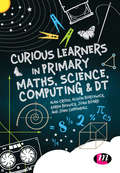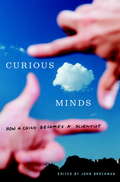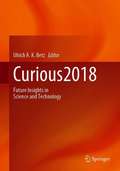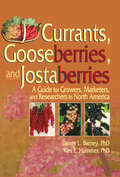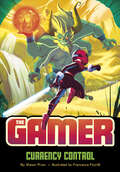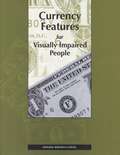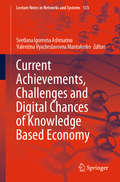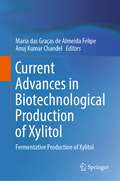- Table View
- List View
Cupcake Fix: A Branches Book (Layla and the Bots #3)
by Vicky FangLayla and the Bots are building a SWEET new invention!Pick a book. Grow a Reader!This series is part of Scholastic's early chapter book line Branches, aimed at newly independent readers. With easy-to-read text, high-interest content, fast-paced plots, and illustrations on every page, these books will boost reading confidence and stamina. Branches books help readers grow!Blossom Valley is opening a new community center! But they need to generate buzz for the grand opening. Layla and the Bots know how to help: they will build a cupcake machine for the party! But will their invention be a piece of cake... or a recipe for disaster? With full-color artwork on every page, speech bubbles throughout, and a fun DIY activity that readers can try at home, this early chapter book series brings kid-friendly STEAM topics to young readers!
Curators: Behind the Scenes of Natural History Museums
by Lance GrandeOver the centuries, natural history museums have evolved from being little more than musty repositories of stuffed animals and pinned bugs, to being crucial generators of new scientific knowledge. They have also become vibrant educational centers, full of engaging exhibits that share those discoveries with students and an enthusiastic general public. At the heart of it all from the very start have been curators. Yet after three decades as a natural history curator, Lance Grande found that he still had to explain to people what he does. This book is the answer—and, oh, what an answer it is: lively, exciting, up-to-date, it offers a portrait of curators and their research like none we’ve seen, one that conveys the intellectual excitement and the educational and social value of curation. Grande uses the personal story of his own career—most of it spent at Chicago’s storied Field Museum—to structure his account as he explores the value of research and collections, the importance of public engagement, changing ecological and ethical considerations, and the impact of rapidly improving technology. Throughout, we are guided by Grande’s keen sense of mission, of a job where the why is always as important as the what. This beautifully written and richly illustrated book is a clear-eyed but loving account of natural history museums, their curators, and their ever-expanding roles in the twenty-first century.
Curbing Energy Poverty in Sub-Saharan Africa: A Multi-Objective Optimization Approach for Achieving Universal Access
by Pitshou Ntambu Bokoro Gulshan SharmaThis book emphasizes the critical need for a multi-dimensional approach to tackling energy poverty, advocating for an integrated strategy that addresses three interconnected dimensions: availability, accessibility, and affordability. It introduces a robust Multi-Criteria Decision-Making (MCDM) framework based on a dynamic model that links off-grid energy supply to rural households primarily engaged in crop farming as a key economic activity. The framework leverages the Non-Dominated Sorting Genetic Algorithm II (NDSGA-II), a powerful multi-objective optimization technique, to balance the trade-offs between costs and revenues, ensuring the sustainable delivery of energy services to rural communities. By underscoring the interplay between availability, accessibility, and affordability, the approach reveals that while costs are primarily associated with securing energy availability, revenues are essential for enhancing both accessibility and affordability. This comprehensive and holistic strategy offers an innovative solution to the multifaceted challenges of energy poverty in rural areas, ensuring long-term sustainability and economic viability.
Cured of Cancer: from childhood to adulthood, quality of survival (AUP Dissertation Series)
by N.E. LangeveldNeeltje Elisabeth Langeveld (1954) worked at the Emma Children’s Hospital where she was promoted to the position of Research Nurse in the Children’s Cancer Department. From 1990 she trained in Clinical Epidemiology for Nurses at the AMC. In 1996 she started the research which is the subject of this dissertation. She will remain active as Research Nurse in the Children's Cancer Department when she has completed it. This dissertation focuses on aspects of the quality of life of young adults who have recovered from childhood cancer. Some fivehundred childhood cancer survivors, aged from 16 to 49 years, were asked to complete a questionnaire during their annual clinical check up at the ‘Polikliniek Late Effecten Kindertumoren’ (plek). The dissertation compares the results with a control group of subjects who had never suffered from cancer.
Curing Concrete
by Peter C. TaylorCuring is one of those activities that every civil engineer and construction worker has heard of, but in reality does not worry about much. In practice, curing is often low on the list of priorities on the construction site, particularly when budgets and timelines are under pressure. Yet the increasing demands being placed on concrete mixtures also
Curiosity: How Science Became Interested in Everything
by Philip BallWith the recent landing of the Mars rover Curiosity, it seems safe to assume that the idea of being curious is alive and well in modern science—that it’s not merely encouraged but is seen as an essential component of the scientific mission. Yet there was a time when curiosity was condemned. Neither Pandora nor Eve could resist the dangerous allure of unanswered questions, and all knowledge wasn’t equal—for millennia it was believed that there were some things we should not try to know. In the late sixteenth century this attitude began to change dramatically, and in Curiosity:How Science Became Interested in Everything, Philip Ball investigates how curiosity first became sanctioned—when it changed from a vice to a virtue and how it became permissible to ask any and every question about the world. Looking closely at the sixteenth through eighteenth centuries, Ball vividly brings to life the age when modern science began, a time that spans the lives of Galileo and Isaac Newton. In this entertaining and illuminating account of the rise of science as we know it, Ball tells of scientists both legendary and lesser known, from Copernicus and Kepler to Robert Boyle, as well as the inventions and technologies that were inspired by curiosity itself, such as the telescope and the microscope. The so-called Scientific Revolution is often told as a story of great geniuses illuminating the world with flashes of inspiration. But Curiosity reveals a more complex story, in which the liberation—and subsequent taming—of curiosity was linked to magic, religion, literature, travel, trade, and empire. Ball also asks what has become of curiosity today: how it functions in science, how it is spun and packaged for consumption, how well it is being sustained, and how the changing shape of science influences the kinds of questions it may continue to ask. Though proverbial wisdom tell us that it was through curiosity that our innocence was lost, that has not deterred us. Instead, it has been completely the contrary: today we spend vast sums trying to reconstruct the first instants of creation in particle accelerators, out of a pure desire to know. Ball refuses to let us take this desire for granted, and this book is a perfect homage to such an inquisitive attitude.
Curious About Pluto (Smithsonian)
by James BuckleyHello, Pluto!What&’s cold, dark, far away, and has a &“heart&” one thousand miles wide? Pluto! In this highly-visual Smithsonian book, kids can check out exciting information and sensational photographs transmitted by the New Horizons spacecraft on its historic fly-by of the distant and mysterious dwarf planet.
Curious Constructions: A Peculiar Portfolio of Fifty Fascinating Structures (Uncommon Compendiums)
by Michael HearstAn illustrated collection of unusual architecture, perfect for young builders, written with a &“wry humor&” that is sure to &“keep readers entertained&” (Publishers Weekly). Curious about constructions? Inside this book, you&’ll come face-to-face with fifty incredible structures, including: a fire-breathing octopus sculpture; the skateboard ramp you&’d need to jump the Great Wall of China; a whole community of tree houses in Costa Rica; and a life-size X-Wing Starfighter built of Legos. These and many more fascinating accounts of constructions both fantastically useful and gloriously unnecessary await inquisitive readers, aspiring engineers, and anyone who ever looked at a skyscraper and thought, &“Yeah, but what if it had a roller coaster on top?&” &“Hearst obviously had a lot of fun compiling this interesting assortment of man-made creations, making great use of wit and puns.&” —School Library Journal
Curious George Discovers Plants (Curious George)
by H. A. ReyGeorge's friend Chef Pisghetti makes the most delicious vegetable soup! When the chef is running low on fresh vegetables, George wants to lend a hand in the rooftop garden--but he has a lot to learn about greenery. Come along as George discovers all about gardening, plants, what makes them grow, and why they're important. Based on the Emmy-winning PBS show, this story is filled to the brim with additional facts, real photos, experiments, activities, and more. Learning about science has never been so much fun!
Curious George Discovers Recycling (Curious George)
by H. A. ReyCurious George wants to help clean up the planet, and recycling seems like a good place to start—but where does he begin? Follow along with George as he learns about what recycling is, how it works, and what else he can do to reduce his monkey paw print. Readers will learn the difference between recycling and trash, what happens to the things we throw away, and other ways to help keep our planet clean. Based on Curious George, the Emmy Award-winning PBS TV show, this story also includes fun facts, real photos, experiments, activities, and more. Learning about science has never been so much fun!
Curious George Discovers Space (Curious George)
by H.A. ReyCurious George embarks on an out-of-this world adventure and lends some helping hands—and feet—to save the space station astronauts. George is thrilled to visit the Space Center to help Professor Pizza and Professor Einstein. First up, he&’s making a special delivery to the international space station. Then it&’s time to help solve a problem with the Mars rover, and George dreams of going where no monkey (or human) has gone before—Mars! Join George on an exciting journey into outer space and learn all about space travel, gravity, the solar system, and Mars. Based on the Emmy-winning PBS show, this story is filled to the brim with additional facts, real photos, experiments, activities, and more. Learning about science has never been so much fun!
Curious George Discovers the Seasons
by H. A. ReyThe seasons are changing and winter is closing in. George has toys for warm weather and toys for snowy weather—but what’s a monkey to do when winter days are just plain cold? When he decides to ignore the weather and play with his wading pool and bubbles, George learns some interesting things about weather, temperature, and freezing and melting. Learn all about the four seasons with your favorite monkey! Based on the Emmy-winning PBS show, this story is filled to the brim with additional facts, real photos, experiments, activities, and more. Learning about science has never been so much fun!
Curious George and the Kite (CGTV Reader)
by H. A. ReyCurious George loves a good windy day. There are many things he can practice flying-like a kite. Now if only he doesn't get too carried away! This early reader explores the concepts of flight and experimentation.
Curious George and the Rocket (Curious George Ser.)
by Margret ReyGeorge takes a giant leap for monkeykind when he gets suited up and blasts off into space in this out-of-this-world interplanetary adventure.This lively story captures George’s adventure of becoming the first space monkey from the classic Curious George Gets a Medal.Praise for the Curious George books“What distinguishes the George stories is where the trouble is—almost never in a person, never in humanity. George lives in a super benign world, even if it is often strange and unfamiliar to him. This is different than living in a world that is familiar but crowded with evil or indifference . . . George is at once an impossible monkey, a fantasy, and also, simply, one of us.” —The New Yorker“Curious George certainly deserves a spot on the shelf, and these engaging stories will provide a good exercise in imagination and creativity.” —The Horn Book
Curious George: Wash Your Hands (Curious George Ser.)
by H. A. Rey H. A. ReyLearn to wash the germs off your hands with Curious George in this playful and informative book for the youngest readers. When should Curious George wash his hands? Why does George wash his hands . . . and how does he do it? Join George on a playful romp through his day as he learns more about germs and hand-washing. This accessible story features informational text about germs and cleanliness for the youngest readers. This is the perfect primer for little ones just learning to wash their hands.
Curious Learners in Primary Maths, Science, Computing and DT
by Alan Cross Jon Board Jon Chippindall Karen Beswick Alison BorthwickWhether it is in the National Curriculum or the Teachers' Standards, promotion of children's curiosity is highlighted as a key part of effective teaching. Curiosity has the potential to enhance learning in all curriculum subjects but it has a special connection with scientific thinking. A curious approach can open up learning in science, computing, design technology and mathematics. This text explores how teachers can harness the power of curiosity in their classroom. Full of practical teaching ideas for engaging learners and making lessons more exciting, it highlights the ways in which STEM subjects can be taught together. Coverage includes: the place of curiosity in subject teaching how curiosity contributes to a learner's overall capability examples of curiosity in primary STEM classes case studies which exemplify curiosity.
Curious Learners in Primary Maths, Science, Computing and DT
by Alan Cross Jon Board Jon Chippindall Karen Beswick Alison BorthwickWhether it is in the National Curriculum or the Teachers′ Standards, promotion of children′s curiosity is highlighted as a key part of effective teaching. Curiosity has the potential to enhance learning in all curriculum subjects but it has a special connection with scientific thinking. A curious approach can open up learning in science, computing, design technology and mathematics. This text explores how teachers can harness the power of curiosity in their classroom. Full of practical teaching ideas for engaging learners and making lessons more exciting, it highlights the ways in which STEM subjects can be taught together. Coverage includes: the place of curiosity in subject teaching how curiosity contributes to a learner′s overall capability examples of curiosity in primary STEM classes case studies which exemplify curiosity.
Curious Minds: How a Child Becomes a Scientist
by John BrockmanA fascinating collection of essays from twenty-seven of the world's most interesting scientists about the moments and events in their childhoods that set them on the paths that would define their lives. What makes a child decide to become a scientist? *For Robert Sapolsky--Stanford professor of biology--it was an argument with a rabbi over a passage in the Bible. *Physicist Lee Smolin traces his inspiration to the volume of Einstein's work he picked up as a diversion from heartbreak. *Mihaly Csikszentmihalyi, a psychologist and the author of Flow, found his calling through Descartes. *Mary Catherine Bateson--author of Composing a Life--discovered that she wanted to be an anthropologist while studying Hebrew. *Janna Levin--author of How the Universe Got Its Spots--felt impelled by the work of Carl Sagan to know more. Murray Gell-Mann, Nicholas Humphrey, Freeman Dyson, Daniel C. Dennett, Lynn Margulis, V. S. Ramachandran, Howard Gardner, Richard Dawkins, and more than a dozen others tell their own entertaining and often inspiring stories of the deciding moment. Illuminating memoir meets superb science writing in essays that invite us to consider what it is--and isn't--that sets the scientific mind apart and into action.
Curious2018: Future Insights in Science and Technology
by Ulrich A. K. BetzThis book expands the debate on the future of science and technology at the Curious2018 – Future Insight Conference, held on the occasion of Merck’s 350-year anniversary. In the respective chapters, some of the world’s top scientists, managers and entrepreneurs explore breakthrough technologies and how they can be applied to make a better world for humanity.Divided into three parts, the book begins with an introduction to the vision of the conference and to the importance of curiosity for innovation, while also exploring the latest scientific developments that are shaping the future of healthcare, medicine, the life and material sciences, digitalization and new ways of working together. In the second part, particular attention is paid to new therapies and diagnostics; here, readers will learn how synthetic biology and chemistry are being used to solve problems that are essential to the future of humanity. The role of in-silico research is also discussed. In the final part of the book, readers will find some thoughts on ethical principles guiding our application of science and technology to create a bright future for humanity.Given its interdisciplinary appeal, the book will inspire curiosity in a wide readership, from scholars and researchers to professionals with an interest in exploring the future of science and technology, solving the problems of today, and paving the way for a better tomorrow.Chapters 1, 2, 3 and 17 are available open access under a Creative Commons Attribution-NonCommercial 4.0 International License via link.springer.com.
Currants, Gooseberries, and Jostaberries: A Guide for Growers, Marketers, and Researchers in North America
by Kim Hummer Danny BarneyRediscover the economic potential of growing Ribes cultivars in the United States and Canada! Currants, Gooseberries, and Jostaberries: A Guide for Growers, Marketers, and Researchers in North America explores the biology and history of growing these small fruits as commercial crops in North America. This book provides authoritative inf
Currency Control (The Gamer)
by Shawn PryorEvil Cynthia Cyber is robbing banks with her latest creation, a villain named Currency. The stolen money will go toward building a machine that can capture people in a simulation program. There she could control every victim’s life. It's up to the Gamer to stop Cynthia Cyber from taking over the world!
Currency Features for Visually Impaired People
by Committee on Currency Features Usable by the Visually ImpairedThe Committee on Currency Features for the Visually Impaired evaluated features that could be incorporated in the production of U.S. banknotes that would enable blind and visually disabled people to more easily determine the denomination of a banknote. This volume describes several features and the assessment methodology used to determine which features could be recommended for inclusion in the short term, which could be recommended for research and possible inclusion in future currency redesigns, and which features were impractical for use in U.S. banknotes. Also included is an outline of the various types of visual disabilities that impair an individual's ability to denominate banknotes. Recommended features and areas of research are described in detail. Banknote and other security document producers, and people interested in addressing needs and opportunities for visually disabled people in the United States will find this book useful.
Current Account Determinants for Oil-Exporting Countries
by Hanan MorsyA report from the International Monetary Fund.
Current Achievements, Challenges and Digital Chances of Knowledge Based Economy (Lecture Notes in Networks and Systems #133)
by Svetlana Igorevna Ashmarina Valentina Vyacheslavovna MantulenkoThis book is based on research from Russia, Hungary, Bulgaria, Great Britain, Switzerland and the Czech Republic on issues related to knowledge-based economy development. The idea for this book was developed during three international conferences on digitalization: VI, VII and VIII International Scientific Weeks, organized by Samara State University of Economics (Samara, Russia) in 2018–2020. It is an initiative by the scientific and business organizations in the Samara Region and their Russian and international partners to analyze the current digitalization of social-economic systems, the problems and perspectives of this process, and its role in the creation and development of a new type of economy and new quality of human capital. All the contributions focus on the search for effective ways of adapting to the new digital reality and are based analyses of international statistics, and data from specific companies, educational institutions and governmental development programs.The book explores a variety of topics, including • Knowledge and Information as Basic Values of a New Economic Paradigm;• Information Technologies for Ensuring Sustainable Development of Organizations;• Augmented Reality, Artificial Intelligence and Big Data in Education and Business;• Digital Platforms and the Sharing Economy;• Potential of Digital Footprints in Economies and Education; • Sociocultural Consequences of Digitalization.
Current Advances in Biotechnological Production of Xylitol: Fermentative Production of Xylitol
by Anuj Kumar Chandel Maria das Graças de Almeida FelipeThis book explores recent advances in the microbial production of xylitol and its applications in food and medical sector. Xylitol is an important biomolecule from lignocellulose biorefinery which is produced from the xylose by chemical reactions or microbial fermentation methods. Currently, the demand of xylitol at commercial scale is being met through chemical methods. However, recent breakthroughs made in plant cell wall destruction, genetic engineering to develop the designer microorganisms, fermentation methods and media formulations and downstream processing have led the ways for sustainable production of xylitol at commercial scale in lignocellulose biorefineries. Microbial production of xylitol is preferred over the chemical processes as it is environmentally friendly, higher process efficiency with the desired product yield, and product recovery with minimum impurities. This book is a unique compilation of 11 book chapters written by experts in their respective fields. These chapters present critical insights and discuss the current progress and future progress in this area into fermentative xylitol production.Chapter 9 is licensed under the terms of the Creative Commons Attribution 4.0 International License. For further details see license information in the chapter.
